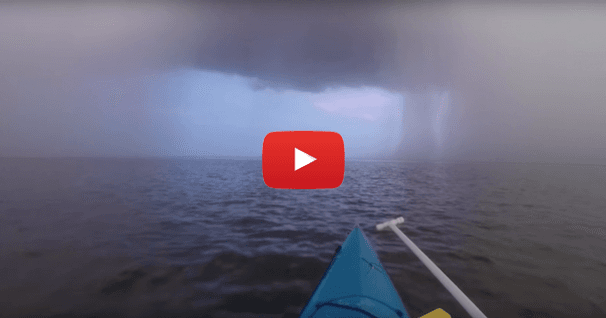How to Tow a Kayak: Contact Tows
My preferred method of a contact tow starts with piece of cord with a hook on each end; and I use it like this. I put it through the deck lines on both sides, bring it back up to the middle and then it crosses over and comes down onto the deck line. When it comes back onto the deck line, it's out of the way.
Close Contact Tow And with this one I can do a close tow there, or I can make it longer if the condition is needed to be longer just by unhooking that, putting it in there, and then letting that do its own thing.
So, my preferred one this time is using the crossover; just unhook it from our own board, clip it on here, and pull the back board back.
Extended Contact Tow So this time we'll do the extended version of the crossover. Just take it out from there, clip it on again, and you can see the difference in where the person sits now in relation to my boat. So it's a good bit further behind me so I can paddle slightly more efficiently. The only downside with it is this can move up and down an awful long way under my armpit.
Varying the Length of Tow Line Being able to vary the length of the contact tow also allows you to tow longer and shorter kayaks.
You can see I'm having to modify my strokes as I'm paddling to see if I'm hitting things off the front end of the boat.
Making a Tow Rope
It's easy to make your own contact tow. Use a length of cord about four to five millimeters wide and three times the length of the distance between your deck lines. You also need two stainless steel hooks with no teeth on which ropes can snag. The carbineer type hooks which do have teeth are best avoided. All this can be bought at most marine stores. And whatever tow you're using clip the correct way.
Clipping On
When I'm clipping it's important that we do it the right way, so always from below onto one deck line only. The reason for that is this if this should fail, we have a lot of rope here, and we've got all these other deck fittings to spread the load. A free clip from above it can release itself, and then we're left wondering how that happened. So always clip from below onto one deck line.
Practice Tow in Deep Water
Now we'll practice a contact tow in a choppy sea. Janice has volunteered to get wet again. If someone's in the water and they let go of their boat, we can get their boat back to them. So, Janice, if you could just hold your paddles straight up in the air, I'll come back and get you in some boat, okay?
Gordon goes to the kayak first, because it's easier to tie a kayak to a swimmer than a swimmer to a kayak that's being carried away by wind or tide.
The video clip shown above is a segment taken from the DVD: "Sea Kayak with Gordon Brown: Volume 2"
Related Articles
When Christian Nelson’s kayak turned turtle 3 miles offshore, a friend’s cell phone was his only way to…
In this video, Chad is kayak fishing in the river in Happy Valley, Pennsylvania. He shares important…
This Point Of View account of the decisions made prior to an outing visibly shows the importance of why…
Even if you do your research and check the weather before heading out, sooner or later every kayak…



